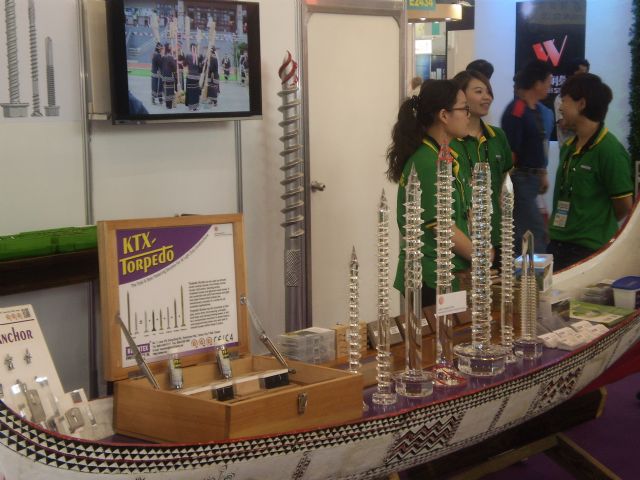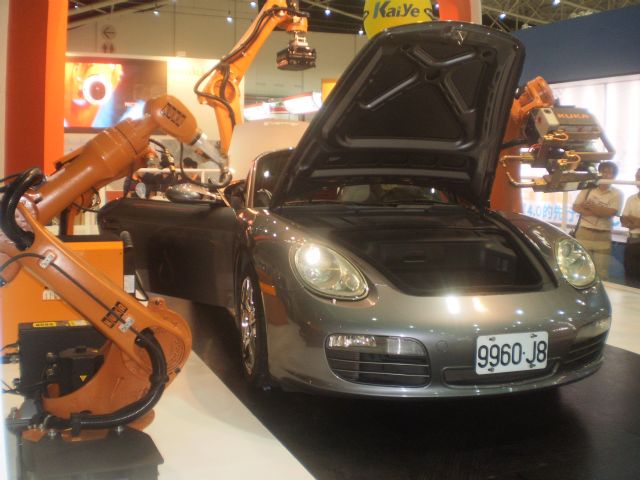MIRDC Analyst Shares Views to Dispel Doom of Red Supply Chain on Taiwan's Fastener Industry
Taiwan-to-China fastener exports in Jan.-July 2015 total 11,000 tonnes versus only 3,000 tonnes of imports
2015/10/01 | By Steve Chuang
The rise of China’s “red supply chain,” a term coined by market observers for aggressive development of Chinese tech industries backed by the central government to minimize dependence on imports and secure sustained economic growth, is widely regarded a growing threat to Taiwanese manufacturers, especially those from the island’s industries supplying products and services overlapping those from their Chinese counterparts. However, as any new trend, the red supply chain will unlikely wield blanket effect upon all Taiwanese suppliers, with Taiwan’s fastener suppliers to stand a promising chance to further enhance their global presence for a couple of reasons.
Impact on Taiwan’s Electronic Industry
Ample statistics show the real-world impact of the red supply chain on Taiwan’s export-driven manufacturing industries that rely on the Chinese market, especially the electronic parts and components industry, a major contributor to the island’s GDP growth.
According to a report issued by the Ministry of Economic Affairs (MOEA), annual exports of Taiwan’s electronic parts and components have plummeted over the past few years, from over NT$550 billion (US$17.18 billion) in 2012 to less than NT$300 billion (US$9.37 billion) in 2013. Despite such exports seeing a 2.7% growth last year over 2013, MOEA officials concede that the industry’s exports are unlikely to return the NT$500 billion level in the short term, mostly due to the emergence of the red supply chain.
Such pessimism has been further justified by MOEA’s statistics that show Taiwan’s exports of electronics and ICT (information and communication technology)-based products having dropped 0.7% and 12.3%, respectively, to US$5.58 billion and US$46.68 billion, in the first half of 2015, compared to the same period of last year.
With ever more Chinese electronic parts and components suppliers being aided by their governments to upgrade technology and manufacturing capability, MOEA officials warn that the tilting of the playing field in China will not only gradually sideline Taiwanese suppliers in the Chinese market, but will likely lead to Taiwan to be replaced in the global supply chain in the future, as Chinese suppliers continue to gain expertise and capacity.
In addition to Taiwan’s electronics industry, the sectors of precision machinery, display panels, semiconductors, LEDs, integrated circuits, etc. also stand to be pushed into the shadow of Chinese counterparts as China continues to invest in breeding the local tech industries. However, not all Taiwan’s export-dependent industries would be steam-rolled by this overwhelming trend.
The adage "one man's bane is another man's bounty" also holds true amid this market change. The fastener industry among Taiwan’s other sectors is likely to benefit from the red supply chain in many ways, or to be spared from the threat, which has been proven so far as the sector remained in comparatively good shape during the first half of 2015, according to Kristy Chi, industrial analyst from the Metal Industries Research & Development Centre (MIRDC), a Taiwanese government-funded R&D and market research institute, in an exclusive interview with CENS.

Robust Growth
Chi reported that Taiwan’s fastener exports for H1, 2015 totaled some 812,000 tonnes with value of NT$66.16 billion (US$2.06 billion) for a 3.8% and 5.3% increase, respectively, eclipsing the 782,000 tonnes and NT$62.84 billion (US$1.96 billion) attained a year ago.
Considering that the industry had just recorded a 10-year high annual export revenue of over US$4 billion last year, Chi noted that the H1 results were undoubtedly encouraging, especially when Taiwan’s overall exports during the same span suffered a 7.1% year-on-year drop amid various negative factors, including the increasingly uncertain global economy, slower-than-expected inventory depletion by downstream manufactures and branded vendors worldwide, growing inertia among global enterprises to invest in fixed assets, rising geopolitical risks, comparatively high NT-dollar-to-greenback ratio than that of Japanese yen, Korean won and euro, slowing economic growth in China, and effects of the red supply chain.
Chi furthered that in August, when Taiwan’s overall exports continuously dived 14.8% year on year, the industry still kept in fine shape, as reflected by its August exports, which were estimated to have reached 128,000 tonnes with value of NT$10.15 billion (US$317.18 million), with volume dipping only 2.7% from 132,000 tonnes last August. These figures somehow again manifest the industry’s ability to weather China’s industrial restructuring.
From another viewpoint, Chi indicated that Taiwan’s huge fastener trade surplus with China also attests to Taiwanese suppliers’ irreplaceable role in the emerging market. She reported that in January-July, 2015 Taiwan’s fastener exports to China totaled 11,000 tonnes with value of NT$1.92 billion (US$60 million), compared to imports of only 3,000 tonnes valued at NT$190 million (US$5.93 million).
More notable is, Chi stressed, that Taiwan’s average export price to China in August stood at NT$181.7 (US$5.67) per kilogram, much higher than the industry’s annual average of NT$80.9 (US$2.52) in 2014, indicative of growing popularity of Taiwan-made fasteners in China, where its higher-end industries, such as automobiles, aerospace, ICT products, etc., are generally gaining steam from governmental support to develop rapidly.
Diligent Improvement
Explaining why Taiwanese fastener suppliers are able to shrug off the impact of China’s recent industrial restructuring, Chi pointed out that the industry, in fact, had experienced two crises that might have led to catastrophic consequences since it began full production using carbon steel three decades ago: once in 2000 when massive migrations of Taiwanese makers to China for cheaper operating cost had caused the industry to greatly shrink; and the other in 2008 when the industry was severely hammered by the global financial tsunami. “Both fundamental changes did not derail the industry, which has successfully survived and steadily expanded since, mostly thanks to operators’ diligent, consistent efforts on sharpening competitive edge even if the going gets tough,” said Chi.
One result of the sustained effort, she added, is that many Taiwanese fastener makers have successfully moved upmarket over the past few years from the segment of DIY-caliber, standardized fasteners to higher-end applications, including products for construction and car production, hence driving up the industry’s overall gross profit margins and laying solid foundation for sustainable growth. She went on, “A few operators have even been exploring the segment for top-end fasteners for use in the aerospace industry, with some having already passed strict certification by airplane builders and landed trial orders from globally known firms, such as Boeing.”

Potential Benefits
Backed by time-tested capabilities and adhering to policy of continuous improvement, Taiwanese fastener suppliers, Chi said, will weather impacts of the red supply chain and likely benefit from it in the short term for several reasons.
With technological advancement, Chi indicated that ever more advanced fasteners are developed using state-of-the-art technologies for high degrees of precision and higher-end applications, a trend that is likely to help Taiwanese suppliers find their way into China’s market for industrial automation solutions, part of its industrial restructuring and upgrading policy.
Citing the "Rota Bolt" developed in the U.K., Chi reported that it is the world’s first fastener integrated with a wireless remote control system to monitor and control changes in tension after installation. She said that the system can track a number of such bolts, collect data on tension, and automatically report variations through GSM and Internet to remote servers, as well as to technicians responsible for mechanical maintenance through email and text messages, to greatly enhance safety. This is a striking example of smart fasteners suitable for industrial automation.
Riding such cutting-edge trend, Chi confirmed that a few Taiwanese fastener makers have worked out similar smart fasteners applied as part of a remote control system to monitor conditions of bridges, roads, buildings, etc., as well as in airplane engines and other key components prone to vibration, precision equipment, communication instruments, electric wave filters and many others.
Although the red supply chain is seen to have negative effects on Taiwan’s tech industries, including electronics, LCDs, LED lighting, photovoltaics and handsets, given that more Chinese makers in the said sectors are occupying greater presence in the global market, Chi feels that this trend can actually be positive for Taiwanese fastener makers, especially those with in-house R&D capabilities for testing and inspection equipment.
She explained that many of Taiwan’s fastener makers have ventured into researching and developing necessary testing and inspection equipment for some time since some of their German and Japanese counterparts have withdrawn from the competition, to have hence accumulated ample know-how and techniques to make and supply such equipment. Through exploring the upstream side of the supply chain in China, Chi stressed, Taiwanese suppliers will likely carve out bigger niches than simply supplying fasteners to compete against local rivals, which is realistic especially when China still lacks necessary technology and experience to develop such machines. She added that in case China decides to pour more resources into developing a thorough fastener supply chain locally, the fastener industries in Taiwan and China can even tap competitive symbiosis to reap mutual benefits in the future.
Since car production continues to be one of China’s pilot industries that is pivotal to the country’s industrial upgrading, Chi also believes that Taiwanese makers who have already become contract fastener suppliers to European, Japanese and American carmakers will likely profit amid the rise of the red supply chain.
To that end, Chi suggests Taiwanese fastener suppliers with plentiful financial resources seek mergers and acquisitions of foreign counterparts with ties to carmakers, so as to step up penetrating China’s automotive fastener market, and strengthen their presence in the global automotive industry. For instance, Chi mentioned that a Taiwanese large-sized fastener maker had acquired Germany’s ESKA, Europe’s top-3 automotive fastener maker by size and a Tier-1 supplier to Benz, BMW and Volkswagen, in 2014, a move that has proven effective for the Taiwanese firm to raise its profile over peers in China’s automotive industry.
Since Taiwan’s fastener industry still has a significant technological lead over its Chinese counterpart, a gap unlikely to be narrowed in the short term even with governmental support, Chi concluded that in the face of market and industrial restructuring, Taiwanese suppliers should just continue to focus on R&D and continuous improvement of manufacturing techniques without neglecting their core competencies. “After all, fastener production is one of Taiwan’s most globally competitive industries, and the sector has built a solid reputation and huge customer base, hence making Taiwan a globally top-3 fastener supplier,” she said.

| Taiwan Fastener Industry’s Exports | ||
|
| Export Value
| Export Volume
|
| H1, 2014
| NT$62.84 Bn.
| 782,000 tonnes
|
| H1, 2015
| NT$66.16 Bn.
| 812,200 tonnes
|
| YoY Growth Rate
| 5.3%
| 3.8%
|




